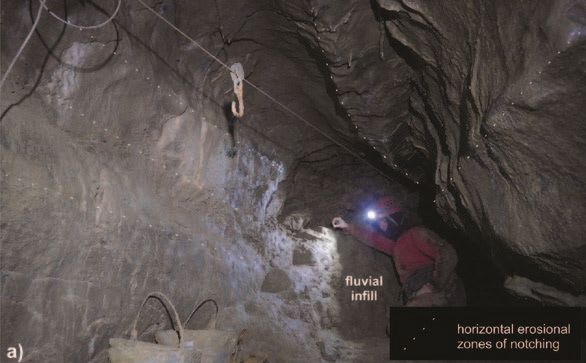Early Pleistocene age of fluvial sediment in the Stará Garda Cave revealed by 26Al/10Be burial dating: implications for geomorphic evolution of the Malé Karpaty Mts. (Western Carpathians)
DOI:
https://doi.org/10.3986/ac.v46i2-3.5157Keywords:
Western Carpathians, Malé Karpaty Mts., fluvial cave sediment, burial dating, Early Pleistocene, neotectonicsAbstract
Assessment of vertical movements of tectonically bounded
blocks is crucial for determination of geohazards in densely
inhabited zones, such as the border zone of western Slovakia
and eastern Austria. The morphostructure of the Malé Karpaty
Mts. divides the Vienna and Danube basins in the Western
Carpathian – Eastern Alpine junction, and its neotectonic
activity is of high importance. This study was focused on
26Al/10Be burial dating of fluvial sediment in the Stará Garda
Cave, located in the central part of the mountains. The structural
research revealed predisposition of forming of horizontal
passages in low angle to subhorizontal bedrock stratification
together with low-grade metamorphic foliation. Fluvial origin
of the passages was inferred from mezoscale erosional features
on the bedrock as well as from facies character of the well preserved
sedimentary profile. Cave sediment was according to
petrographic analysis derived from a watershed comparable
to recent one of the Stupavský Potok Stream. Three analysed
dating samples provided low values of isotopic concentrations,
allowing us only to calculate the minimum burial age of the
deposit of 1.72 Ma. Assuming the low position of the cave
above recent surface streams, resulting maximum incision rate
of 26 m/Ma indicates very low uplift of the mountains horst
during the Quaternary. The slow incision of the river network
is in good agreement with a widespread preservation of the
planation surface called "Mid-mountain level". In contrast are
relatively high values of palaeodenudation rates inferred from
isotopic concentrations. Generally, our results indicate that the
Malé Karpaty Mts. horst underwent relatively intense but short
uplift in the Early Pleistocene, followed by very moderate uplift
up to the recent.
Key words: Western Carpathians, Malé Karpaty Mts., fluvial
cave sediment, burial dating, Early Pleistocene, neotectonics.
Zgodnja pleistocenska starost fluvialnih
sedimentov v jami Stará Garda, ki jo je dala 26Al/10Be datacija:
uporabnost za geomorfni razvoj Nizkih Karpatov (Zahodni
Karpati)
Ocena vertikalnih premikov tektonsko omejenih blokov je
ključna za določitev geohazardov v gosto naseljenih območjih.
Morfostruktura Malih Karpatov deli Dunajski in Donavski bazen
na stičišču Zahodnih Karpatov – Vzhodnih Alp in njegova
neotektonska aktivnost je zelo pomembna. Študija se je posvetila
26Al/10Be dataciji fluvialnih sedimentov v jami Stará Garda
v osrednjem delu gorovja. Strukturna raziskava je razkrila
predispozicijo
oblikovanja vodoravnih jamskih rovov pod nizkim
kotom v odvisnosti od subhorozontalne stratifikacije kamnine
ter tudi z nizko stopnjo metamorfne foliacije. Na fluvialno
poreklo rovov smo sklepali iz srednje velikih erozijskih oblik na
njihovih stenah kot tudi iz lastnosti faciesov dobro ohranjenega
sedimentnega profila. Glede na petrografske analize
jamski
sediment izhaja iz povodja, ki je primerljiv z recentnim povodjem
potoka Stupavský. Trije analizirani vzorci so nam dali
nizke vrednosti koncentracij izotopov, ki so nam omogočile
le izračun najnižje pokopne starosti sedimenta, ki je znašala
1,72 Ma. Če upoštevamo, da leži jama nizko nad recentnimi
vodnimi tokovi, dobimo maksimalno hitrost vrezovanja dolin
samo 26 m/Ma, kar kaže na zelo majhen tektonski dvig v času
kvartarja. Počasno vrezovanje rečne mreže se dobro ujema s
široko ohranjenim uravnanim površjem, imenovanim »Srednjegorska
uravnava«. V nasprotju pa so sorazmerno visoke
vrednosti hitrosti paleodenudacije, ki izhajajo iz koncentracij
izotopov. Na splošno naši rezultati kažejo, da je bil horst Nizkih
Karpatov podvržen relativno močnemu, toda kratkemu dvigovanju
v spodnjem pleistocenu, ki mu je sledil zmeren dvig do
sedanjosti.
Ključne besede: Zahodni Karpati, Nizki Karpati, fluvialni
jamski sedimenti, pokopna datacija, starejši pleistocen, neotektonika.
Downloads

Downloads
Published
How to Cite
Issue
Section
License
Authors guarantee that the work is their own original creation and does not infringe any statutory or common-law copyright or any proprietary right of any third party. In case of claims by third parties, authors commit their self to defend the interests of the publisher, and shall cover any potential costs.
More in: Submission chapter




